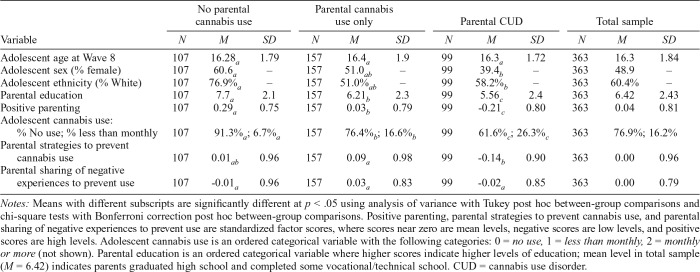Table 1.
Descriptive statistics for all variables by parental cannabis use history and in total sample
| Variable | No parental cannabis use |
Parental cannabis use only |
Parental CUD |
Total sample |
||||||||
| N | M | SD | N | M | SD | N | M | SD | N | M | SD | |
| Adolescent age at Wave 8 | 107 | 16.28a | 1.79 | 157 | 16.4a | 1.9 | 99 | 16.3a | 1.72 | 363 | 16.3 | 1.84 |
| Adolescent sex (% female) | 107 | 60.6a | – | 157 | 51.0ab | – | 99 | 39.4b | – | 363 | 48.9 | – |
| Adolescent ethnicity (% White) | 107 | 76.9%a | – | 157 | 51.0%ab | – | 99 | 58.2%b | – | 363 | 60.4% | – |
| Parental education | 107 | 7.7a | 2.1 | 157 | 6.21b | 2.3 | 99 | 5.56c | 2.4 | 363 | 6.42 | 2.43 |
| Positive parenting | 107 | 0.29a | 0.75 | 157 | 0.03b | 0.79 | 99 | -0.21c | 0.80 | 363 | 0.04 | 0.81 |
| Adolescent cannabis use: % No use; % less than monthly | 107 | 91.3%a; | 6.7%a | 157 | 76.4%b; | 16.6%b | 99 | 61.6%c; | 26.3%c | 363 | 76.9%; | 16.2% |
| Parental strategies to prevent cannabis use | 107 | 0.01ab | 0.96 | 157 | 0.09a | 0.98 | 99 | -0.14b | 0.90 | 363 | 0.00 | 0.96 |
| Parental sharing of negative experiences to prevent use | 107 | -0.01a | 0.96 | 157 | 0.03a | 0.83 | 99 | -0.02a | 0.85 | 363 | 0.00 | 0.79 |
Notes: Means with different subscripts are significantly different at p < .05 using analysis of variance with Tukey post hoc between-group comparisons and chi-square tests with Bonferroni correction post hoc between-group comparisons. Positive parenting, parental strategies to prevent cannabis use, and parental sharing of negative experiences to prevent use are standardized factor scores, where scores near zero are mean levels, negative scores are low levels, and positive scores are high levels. Adolescent cannabis use is an ordered categorical variable with the following categories: 0 = no use, 1 = less than monthly, 2 = monthly or more (not shown). Parental education is an ordered categorical variable where higher scores indicate higher levels of education; mean level in total sample (M = 6.42) indicates parents graduated high school and completed some vocational/technical school. CUD = cannabis use disorder.

